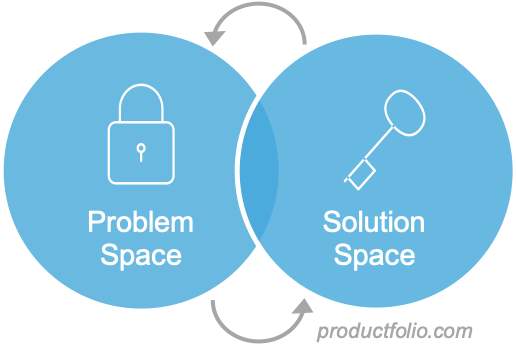Good requirements are essential ingredients for producing winning solutions. However, Product Managers often struggle producing them, giving the engineering team something less valuable to work with. The issues in many cases are misplaced attention and inadequate grasp of the problem we’re trying to solve. PMs often spend less of their time in one of these compared to the other.

What is Problem Space?
Problem space is where the needs of your customers reside. It is where you learn more about users and their problems to enable you to determine what your product needs to do. Essentially, it is the foundation upon which the solution space stands.
However, learning about customers’ needs isn’t the simplest of tasks. It is not always likely that you’ll learn what those needs are easily. The process takes patience and time. To be effective, you require skills that can enable you to win the confidence of the customers and their cooperation.
The seeming difficulty involved in this space can make product management teams want to spend less time in it.
What is Solution Space?
The solution space is where products and product representations that are targeted at the customer live. This is where product managers usually love to spend the bulk of their time.
People are usually encouraged to be problem solvers – to provide solutions. Therefore, it is not surprising that the typical product development team is drawn more to building products. And it may not matter if enough time has been spent understanding the problem to create good requirements – that is where failure starts from.
Place Emphasis More on the Problem Space
Products exist to solve problems. So what happens when you don’t even understand the problems to solve well enough? This can leave you with a “solution” that doesn’t ease the major pain point of your customers. Good luck with achieving your goals when that turns out to be the case.
Although some PMs might wish it were not true, the bulk of their work should be in the problem space. You need to focus more on the problem and less on the solution.

Experts advise that you stay in this space for as long as necessary to get a good grasp of the problem. A basic rule of Blackblot’s Product Manager’s Toolkit (PMTK) goes thus: “Product management resides solely in the problem space.”
Customers buy your product in order to solve pressing problems. With this in mind, it should be less difficult justifying spending more time as necessary in the problem space. This will enable you to define the problem more clearly and come up with good requirements for success.
How to Maintain Focus on the Problem
There are so many things to do in the solution space and these can easily distract you. It is critical to be more attentive and proactive about spending more time in the problem space.
Here are a few tips to help keep your team from easily straying too early into the solution space:
Be in control of discussions – No, we do not mean that you should be the one doing most of the talking. What we mean here is that you should find a way to always bring members on track when you notice a discussion shifting to the solution side too early. This might entail the use of a signal to that end.
Choose your words carefully – The words you use when discussing could either ensure your team focuses more on the problem or otherwise. You may want to employ a term different from “requirement” in that it could be ambiguous – describing both customer pain point or problem and product/solution requirement. You can consider using “customer needs” to describe problems and “product features” to refer to solutions.
Put solutions on hold – Solution ideas may come while you’re discussing problems. However, you should encourage team members to keep from suggesting those yet to avoid derailing. Sticky notes may be provided for noting down whatever idea members might have, with these put aside until you have finished discussing the problem.
Assign Roles Carefully
Thoughtfulness is vital for ensuring that things run smoothly in both problem and solution spaces. You should exercise extra care when assigning roles. It could be very helpful to not assign key activities in both areas to a single individual.
When assigning incompatible roles to an individual, one of those roles will probably be less-covered. The person will more likely than not focus more on the activities they find easier to do at the expense of others. They will pay attention more to the solution space, for instance, if their skills are more suitable to it.
Ensure that all roles that must be assigned to an individual fall in the same space. Avoid giving roles in both spaces to a single person as much as possible. It is better, for example, having an individual perform the roles of a product planner with that of a product marketer than a solution architect.
By drawing attention to the limits between the two spaces and putting the right people in the right places, you improve your chances of delighting your customers with the solutions you offer.


